Sony RX100 VI Review
Sony RX100 VI Review
A brilliant, if slightly flawed, gem of a compact travel camera
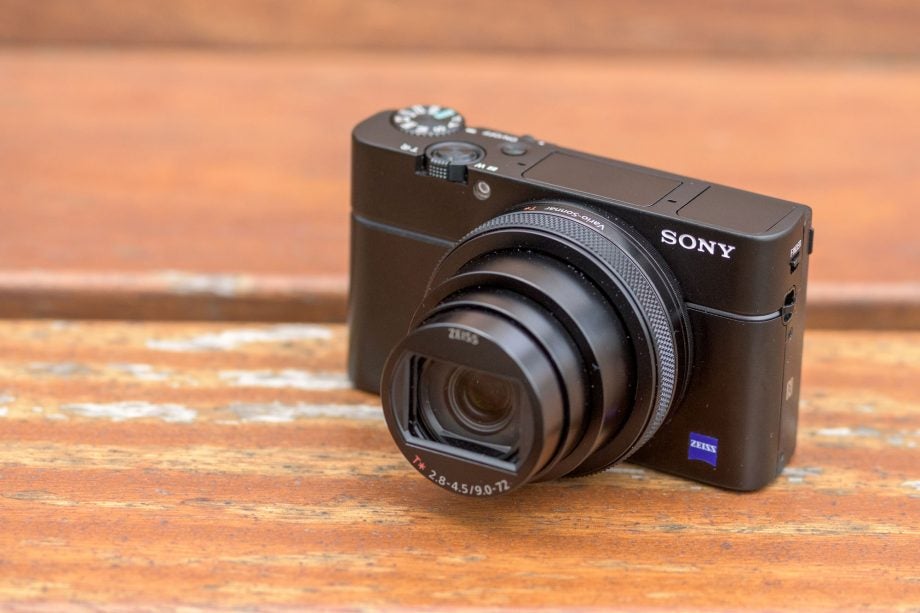
Verdict
Pros
- Impressive lens gives sharp images all through its really useful zoom range
- Very good image quality with reliable exposure
- Remarkably fast autofocus and continuous shooting means you should never miss a shot
- Pop-up viewfinder and tilting screen give flexible composing options
Cons
- Small, slippery body is far too easy to drop without an accessory grip
- Far too expensive compared to its competitors
- Tiny buttons can make operation frustrating
- Comparatively poor battery life
Key Specifications
- Review Price: £1150
- High-zoom, 24-200mm f/2.8-4.5 lens
- Touchscreen LCD for choosing focus points
- Shoots 4K HDR video
- Pop-up XGA OLED viewfinder
- 24fps burst mode shooting
- 4-stop image stabilisation
- 1-inch, 20.1MP Exmor CMOS sensor
What is the Sony RX100 VI?
Since its debut in 2012, Sony’s RX100 series has been on a mission to redefine what we can expect from a premium, large-sensor compact camera.
Successive generations have introduced new features to maintain its lead, with the adoption of a tilting screen in the RX100 II, a pop-up viewfinder and large-aperture zoom in the RX100 III, 4K video in the RX100 IV and high-speed shooting on the RX100 V.
Related: Amazon Prime Day 2019
All of those models remain on sale, which makes sense as the new RX100 VI is a different beast. Sony has previously been happy to let Panasonic own the high-zoom travel compact sector with models like the Lumix TZ200, but the RX100 VI plants a size-10 boot in TZ territory.
Out goes the 24-70mm lens seen on the last three versions, with the RX100 VI instead fronted by 24-200mm lens that gives you the equivalent of an 8.3x optical zoom.
This is still a lot shorter than the 24-360mm of the slightly larger TZ200, and the RX100 VI is significantly more expensive. At a staggering £1150, it’s £300 more than the TZ200, which we already considered very expensive for this kind of camera, and over twice the price of the TZ100.
The RX100 VI does, though, finally give anyone looking for a pocketable, high-quality, long-zoom compact an alternative to the Lumix series.
Sony RX100 VI – Design
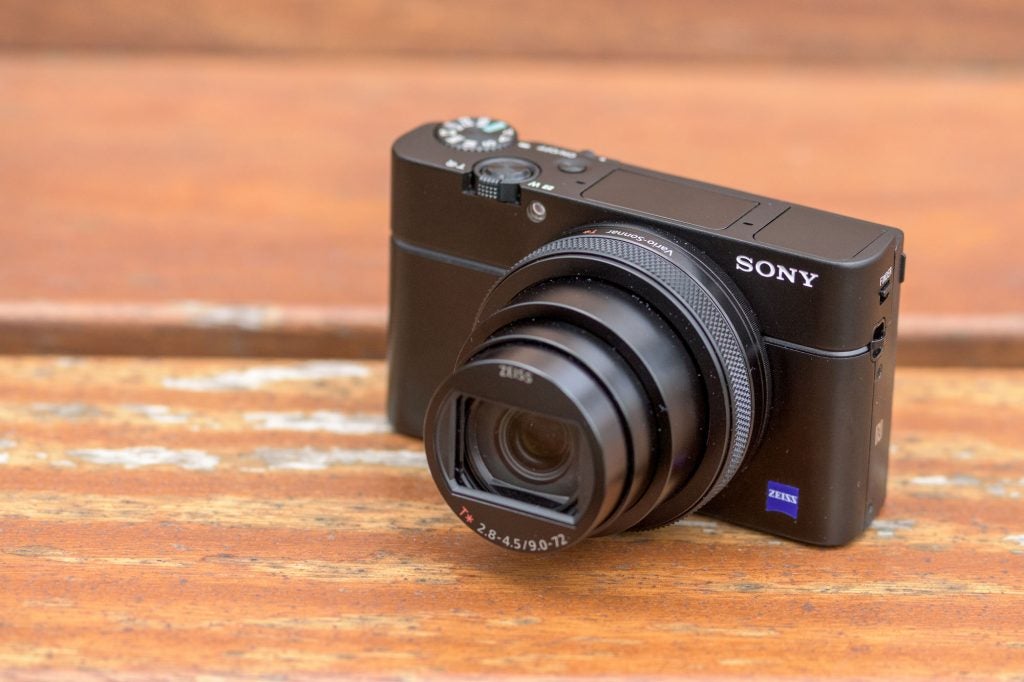
The RX100 VI’s physical design is both hugely impressive and a little frustrating.
On the plus side, Sony has effectively tripled the reach of the lens without making the camera significantly bigger. It’s only 1.8mm deeper than its predecessor, but the same length and width.
Sony’s achieved this by making the lens slower – the maximum aperture now runs from f/2.8-4.5, rather than the f/1.8-2.8 of the previous model. While this may disappoint low-light and shallow depth-of-field fans, others may consider the extra reach worth the sacrifice.
Aside from the lens, Sony has recycled pretty much exactly the same design as the RX100 V. This is a mixed blessing. On the plus side, the metal-shelled body feels reassuringly robust, and the smooth, clean lines make it easy to slip into a pocket, aided by the top-plate controls all being flush to the body.
Both the flash and viewfinder pop up from the top plate, released by mechanical switches; it’s astonishing Sony has managed to fit them in. It’s just a shame Sony can’t make the camera weather-sealed like the Canon G1 X Mark III.
Related: Best Compact Camera 2018
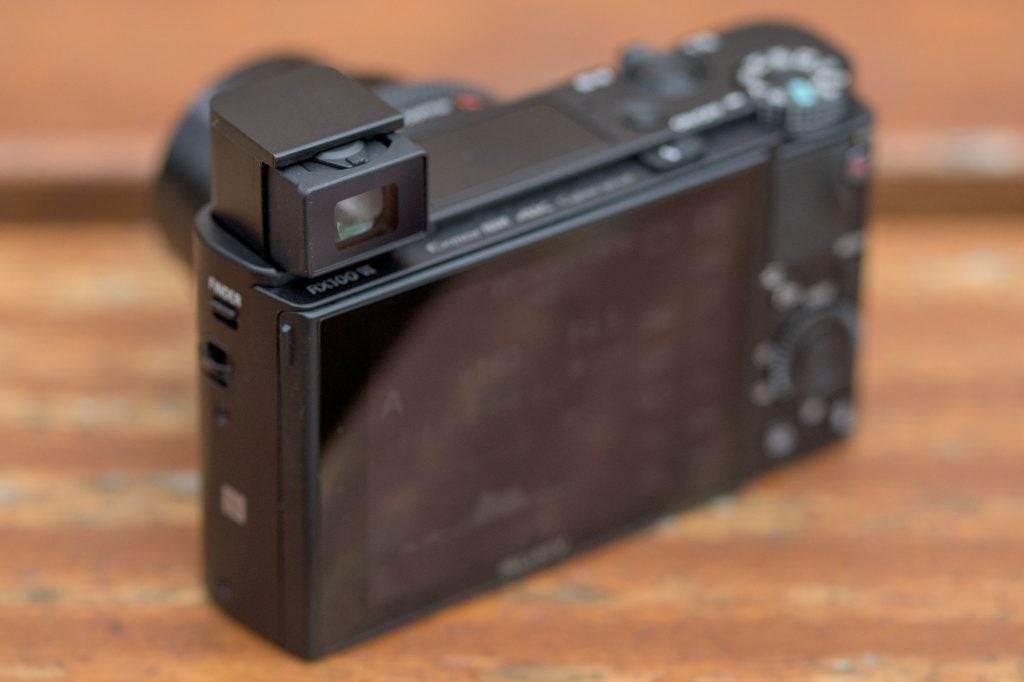
That smooth body has its drawbacks, though: as usual for an RX100, it has all the assured handling of a bar of soap. At the very least you’ll need a wrist strap to save the camera when it inevitably slips from your grasp, and I’d strongly advise adding the stick-on Sony AG-R2 grip, or one of the multitude of third-party alternatives.
But it’s ridiculous that you need a £14 accessory just to be able to hold the thing securely. The grip adds nothing to the camera’s size, so should be built-in from the start, or at least included in the box.
Like its predecessors, the RX100 VI is at times a tricky thing to use too. A good camera should get out of your way and make it easy for you to change all the key settings, but with the RX100 VI, I usually felt like I was fighting against it instead.
At least Sony has now added a touchscreen, meaning it’s finally possible to select the focus point quickly when you’re shooting with either the screen or the viewfinder. You can also double-tap to zoom into images during playback, and then scroll around them to check focus and detail.
But it doesn’t do anything else: you can’t even change any shooting settings or make menu selections by touch. Compared to Canon and Panasonic’s fully-integrated touch interfaces, this just feels lazy; it’s as if the iPhone never happened.
Related: Best Tripods 2018
Sony RX100 VI – Features
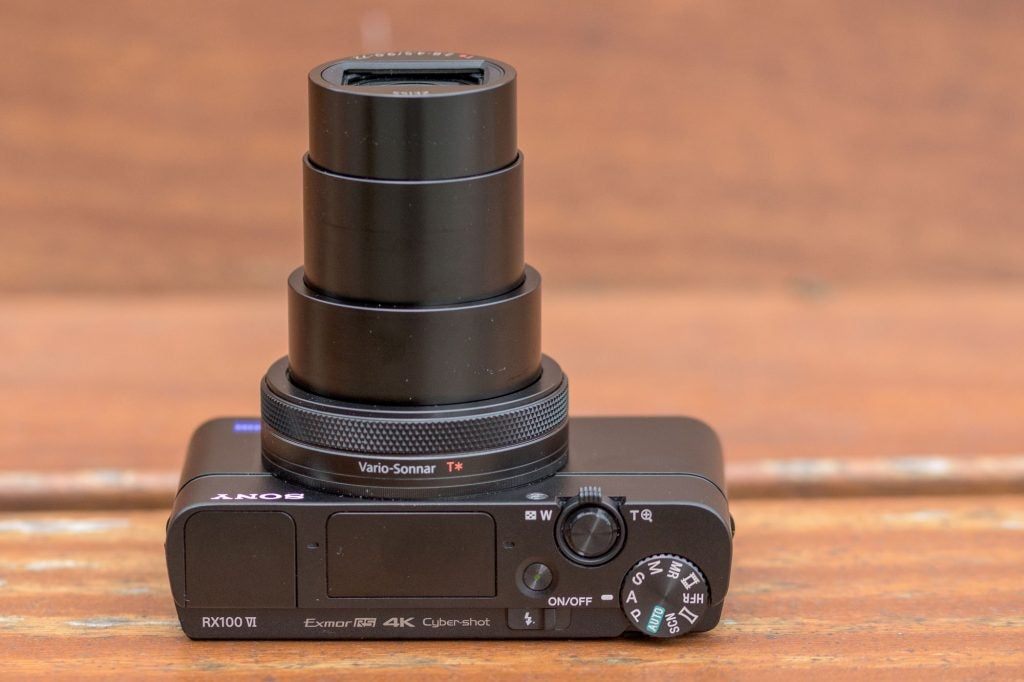
Still, the RX100 VI is about as feature packed as compact cameras come – it’s essentially a pocket-sized Sony Alpha. Sony’s full-frame cameras, including the flagship Alpha A9, are built around a Bionz X processor with front-end LSI, and you’ll find the same combination inside the RX100 VI (albeit in scaled-down form).
Add this to a 1-inch, back-illuminated 20.1MP Exmor CMOS sensor with Fast Hybrid AF and you have a seriously powerful combination. This results in a truly phenomenal continuous shooting rate of 24 frames per second at full resolution, with a 233-shot JPEG buffer, while continuously adjusting focus and exposure between frames. Just how many photographers will need this capability on a pocket compact is a different question.
Low-light shooters would probably still do better to stick to the RX100 V and its shorter-but-faster f/1.8-2.8 zoom, while videographers will be disappointed by the lack of a built-on ND filter. However, photographers who like to shoot portraits will gain more from the extra zoom than they’ll lose from the smaller f-number.
The RX100 VI should give greater background blur than the RX100 V, along with more flattering perspective, if you can take a step or two back from your subject and zoom to 100mm or longer.
Sony claims the RX100 VI’s hybrid autofocus system brings the world’s fastest AF for a 1in sensor camera of just 0.03sec. High-density Tracking AF clusters focus points around moving subjects for increased accuracy, while Sony’s much-touted Eye AF is also onboard for shooting portraits.
As usual from Sony, the RX100 VI has an impressive video specification. It can record 4K 3840 x 2160 footage at 25fps with full pixel readout, which delivers highly detailed footage with no field of view crop. There’s a raft of additional advanced features, including Hybrid Log-Gamma for HDR recording, and super-slow motion video at 250fps, 500fps, or 1000fps. This all makes the lack of any provision for an external microphone for high-quality sound slightly perplexing.
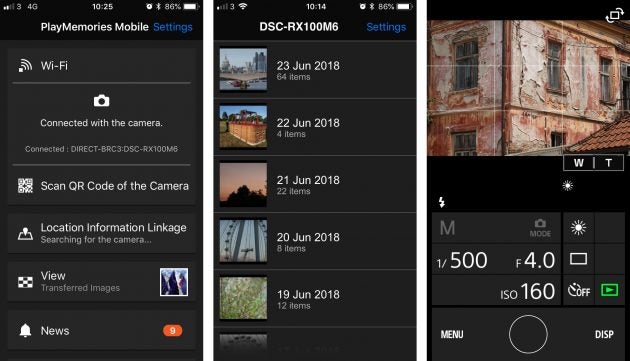
Wi-Fi is of course built in, along with both NFC to quickly set up a connection with compatible Android devices. New to the RX100 series is Bluetooth connectivity, but it’s only used for geotagging your images, and disappointingly you don’t get any of the neat features it brings to the Panasonic TZ200 or Canon PowerShot G1 X Mark III. So you can’t use your phone as a basic, always-connected remote release, or browse through your photos while your camera is safely stowed in your pocket or bag.
Sony’s PlayMemories Mobile app for Android and iOS does at least provide full remote control of the camera complete with live view display, and allow you to transfer images to your phone or tablet for sharing. But it’s relatively clunky and unintuitive and is now looking rather dated.
For example, you have to fire up specifically the remote control mode from the camera itself, and can’t simply take control from the app. You also have to choose between being able to push images from the camera to your phone using the Fn button, or being able to browse the card from your phone – most other brands happily let you do both.
Sony RX100 VI – Viewfinder and screen
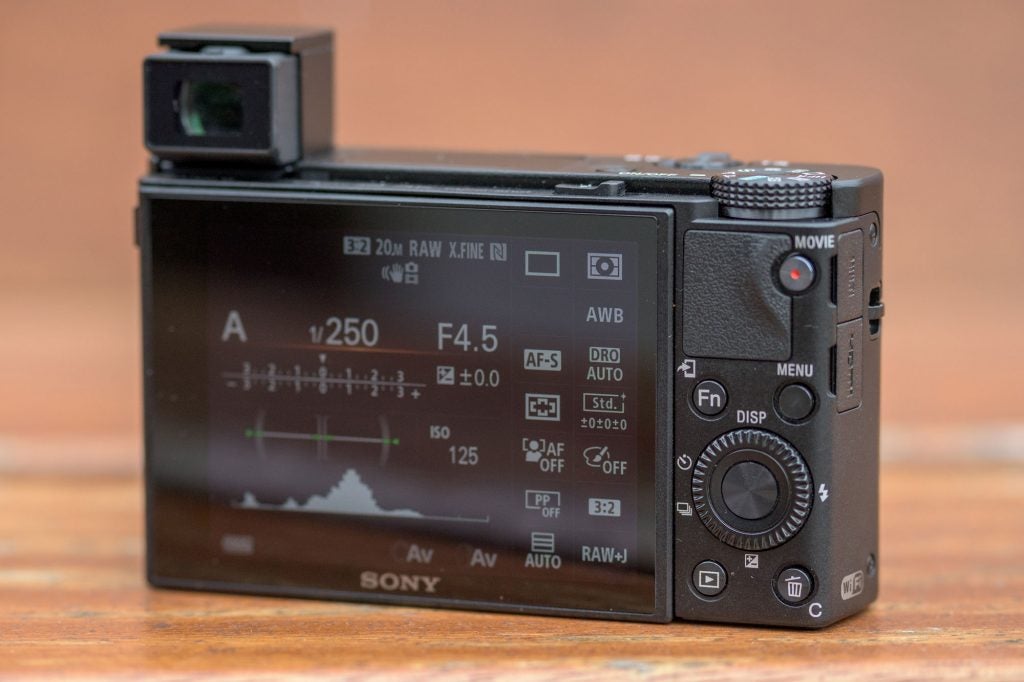
One area where the RX100 VI has a real edge over the Panasonic TZ200, its biggest rival, is when it comes to composing your images.
Its pop-up electronic viewfinder (EVF) is larger than the TZ200’s corner-mounted number. And its screen tilts too, unlike its rival’s fixed equivalent. In fact, its degree of movement is unusually large: a double-hinged design means it can tilt 90-degrees downwards for overhead shooting, or 180-degrees forward for selfies or vlogging.
The screen’s main failing is that it’s not especially bright, so unlike the TZ200’s it’s not very usable in direct sunlight. A super-bright Sunny Weather setting is available to help with this, but requires a trip to the menu to activate. It also has a slight colour cast in the highlights, which is particularly visible when playing back black-and-white images.
Popping-up the viewfinder also turns the camera on, which makes perfect sense. Unfortunately, pushing it down again turns the camera off, which is irritating given that you probably just wanted to use the screen instead. Thankfully, you can disable this behaviour, but only by trawling through the menus.
On a more positive note, the viewfinder itself is really very good: the 2.36-million-dot OLED is bright and clear, and its 0.59x equivalent magnification matches many mid-range DSLRs or mirrorless cameras.
Its design is a considerable improvement on previous RX100 generations too, as you no longer have to pull out the eyepiece after popping-up the EVF, or retract it before pushing the finder back down. This makes a surprisingly large improvement to the experience of using the camera.
Sony RX100 VI – Performance
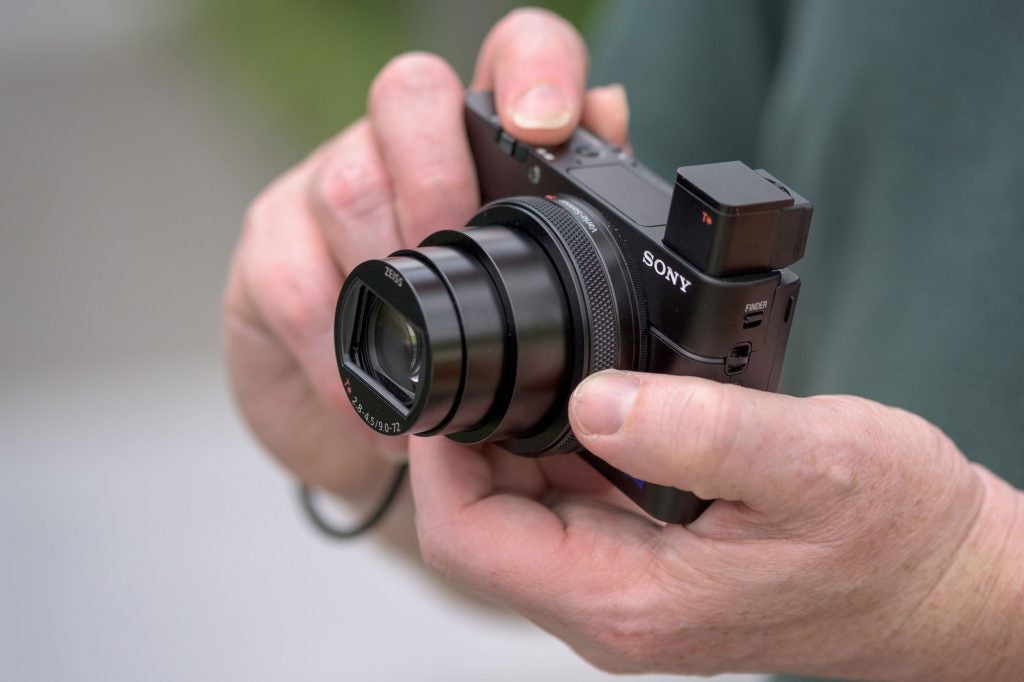
Sony has re-used the same AF system that we’ve seen before on both the short-zoom RX100 V and the RX10 IV bridge camera. I was extremely impressed by it on the latter, and it continues to work in much the same vein on the RX100 VI. It acquires focus on static subjects in the blink of an eye; indeed it’s noticeably quicker than the Panasonic TZ200, which is absolutely no slouch.
It’s when you point the camera at a moving subject that the system really comes into its own. It can keep track of a moving subject, and more importantly keep it in focus, while shooting faster than any interchangeable-lens camera on the planet. Like the RX10 IV it will occasionally drift away from perfect focus for a frame or two, but it’ll quickly snap back. This kind of continuous-AF performance is remarkable for a pocket camera.
With all the processing power it has on board, you’d expect the RX100 VI to be an exceptionally snappy performer, and in most respects it delivers. It powers up in about a second, and from then on responds pretty snappily to all of the controls. In particular its high-speed focusing and shooting means that you should very rarely miss a shot.
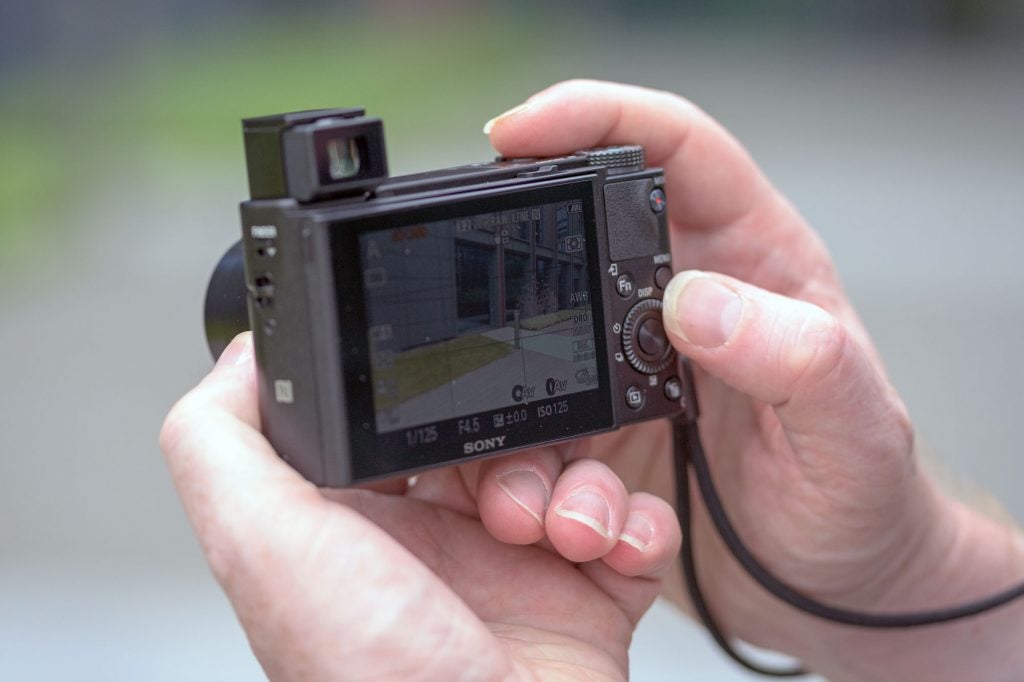
I’ve often found auto white balance to be unreliable on Sony cameras, but I had better luck with the RX100 VI, which generally gave more pleasing results. It even did well under conditions that some other cameras find confusing, for instance neutralising the green colour cast that’s found in the shade of foliage on sunny summer days.
Like all compact cameras, the lens-shutter design is extremely quiet in operation. In fact, if you turn off the various operational beeps and fake shutter sounds and engage the electronic shutter, the camera is completely silent. But then you get no feedback from the camera that it’s actually shooting, so it could really do with the same kind of visual cues Sony has used in its high-speed Alpha 9 mirrorless camera.
One real weakness of the RX100, though, is battery life. The small NB-BX1 battery is rated for 220 to 240 shots per charge, depending on whether you use the LCD or viewfinder. But to get anything close to this in real-world use you’ll probably need to configure much more aggressive power-management settings than Sony’s defaults, and obsessively power the camera off after shooting. Even then, I’d certainly recommend buying a spare battery and an external charger to make sure you can get through the day.
Sony RX100 VI – Image quality

We’ve seen this sensor and processor combination in several Sony cameras now, so it’s pretty much a known quantity. As in the RX100 V and RX10 IV, it delivers highly-detailed images at low ISO settings, while keeping noise fairly well under control at sensitivity settings up to ISO 1600 or so.
The RX100 VI’s lens is an excellent performer considering its relatively long range. Like most extended-range zooms it’s very sharp in the centre wide open, but less good in the corners, and you’ll want to stop it down to f4 or f/5.6 when shooting scenes such as landscapes where there’s detail right across the scene.
In the middle of the zoom range the lens is simply stunning, giving excellent sharpness from corner to corner. Likewise at the telephoto end, the centre is still very sharp, although the corners are a touch soft at maximum aperture.
In my side-by-side comparisons, the RX100 VI’s lens is so much sharper at 200mm and f/4.5 than the TZ200’s at 360mm and f/6.3 that in good light, you can get almost the same level of detail from both cameras when shooting distant subjects. One word of warning though; I’d avoid the minimum aperture of f/11, as it gives very soft images due to diffraction.
Related: Sony RX100 V review

Should you buy the Sony RX100 VI?
There’s no doubt that the Sony RX100 VI is an astounding technological feat. After all, here’s a camera with a 24-200mm equivalent zoom, built-in viewfinder, 24 fps shooting at full resolution, and 4K video recording, all crammed into a body that’s barely any bigger than a bar of soap.
Despite its tiny size, the RX100 VI also has some clear advantages over its Panasonic TZ rivals: it’s quicker, its pop-up viewfinder is larger, and its tilting LCD is extremely useful. Oh, and it takes really good pictures.
This doesn’t mean it’s perfect. The first problem is that £1150 price tag. That’s a lot to spend on what is essentially an upmarket point-and-shoot.
The RX100 VI can also be somewhat fiddly to use. The clickless lens ring, tiny buttons and lack of any finger grip might frustrate more advanced shooters, although it’s largely fine for simpler shooting.
These issues are far from dealbreakers. The RX100 VI is a brilliant camera and more accomplished than the Panasonic TZ200 in several key areas. But personally, I’d struggle to justify spending £1150 on a point-and-shoot that’s sometimes frustrating to use, no matter how good the results, when the Panasonic TZ100 and TZ200 are just so much better value.
Verdict
If you can afford it, and are prepared to put up with its foibles, the Sony RX100 VI is a phenomenally capable pocket travel camera, if not quite as good value as Panasonic’s TZ series.
Trusted Score
Features
| Camera type | Digital Compact |
| Megapixels (Megapixel) | 20.1 |
| Optical Zoom (Times) | 2.7x |
| Image Sensor | 20.1MP, 1in Exmor RS CMOS |
| Optical focal length | 24-200mm equiv f/2.8-4.5 |
| Shutter speed | 30-1/32,000 sec |
| Auto focus | 315 PDAF, 24 CDAF |
| LCD Monitor | 3in 921,600-dot tilting touchscreen |
| Viewfinder | 2.36M-dot OLED, 0.6x magnification |
| Video (max res/format) | 3840 x 2160, 25 fps |
Physical Specifications
| Dimensions Width (Millimeter) | 101.6 |
| Depth (Millimeter) | 58.1 |
| Length (Millimeter) | 42.8 |
| Weight (body only) (Kilogram) | 3016 |

